Can you imagine being eternally judged according to the worst thing you have ever done? As imperfect beings, we have all committed regrettable acts and said things that were less than commendable. But for the vast majority of us, these bad choices have not prevented us from picking up the pieces and moving on with our lives.
Something is seriously wrong when our “correctional system” consistently fails to do any correcting at all.
But for the formerly incarcerated, the worst thing they have ever done haunts them long after they leave prison. Their past often prevents them from securing a job and housing, two essential elements needed to rebuild your life. And when you factor in the environmental circumstances that led to their bad decisions in the first place, you recognize that many of these former offenders have no support system there to guide them down a more virtuous path after they are released.
Without these necessities, recidivism is commonplace. This is why two-thirds of released inmates end up rearrested within three years of their release. This number increases to three-quarters within five years.
Something is seriously wrong when our “correctional system” consistently fails to do any correcting at all. And to be sure, the system has failed. Instead of giving inmates the direction they need to improve their lives and the communities they will eventually, hopefully, return to, we lock them in cages, treat them like animals, and then act shocked when they cannot function in the outside world and end up back in prison.
But where the state and the system it created has failed, the private sector has succeeded in lower recidivism through entrepreneurship.
Second Chances
“We’re all ex somethings,” the “about” section for Defy Ventures reads. The organization was started by Catherine Hoke and uses character development, entrepreneurship, and employment opportunities to change the lives of those currently behind bars.
It is easier to judge others than it is to consider their individual circumstances.
It is all too easy to brush off the incarcerated population of this country as being “where they belong;” they are criminals after all. But the truth of the matter is we are all “criminals” in the eyes of the state. Most of us just never get caught.
Many Americans commit three felonies a day, whether knowingly or not. This is because our criminal codes have become so bloated and arbitrary that it is hard to not break some sort of law. Couple this with the fact that the drug war routinely prosecutes victimless crimes and that many of these “perpetrators” have no history of violence, and you have a large chunk of the prison population that shouldn’t even be there to begin with.
But not all those behind bars are nonviolent offenders, and Defy works with these individuals as well. This is because above all things, Defy believes in second chances, even for violent offenders.
And for anyone thinking that this is far too altruistic a position to take, Hoke herself provides a powerful example. After her best friend was brutally murdered at twelve years old, she took a very harsh stance against the incarcerated population. But that was before she decided to visit a prison and see these inmates firsthand, an experience that was integral in her decision to start Defy.
To help get the point across that we are all guilty of something, the year-long program Defy runs an exercise called, “step to the line.” In this drill, Catherine or another Defy rep asks both its volunteers and their inmates questions like, “have you ever done something you could have been arrested for?” If the answer is yes, then participants must, “step to the line.” Without fail, Hoke says the majority, if not all, of those participating step forward.
She then asks questions like, “who has ever committed a violent crime?” Not who has ever been convicted, but who has ever committed a violent crime. Even those with squeaky clean criminal records have been in a schoolyard brawl before, which means many undoubtedly step to the line.
Where the exercise gets interesting is when Hoke asks those to step forward who were arrested before the age of 16, 13, and then ten. Hoke describes an instance where one inmate was first arrested and put into the system at seven.
This exercise is as much for Defy’s volunteers as it is for the participants. It is easier to judge others than it is to consider their individual circumstances. One of the participants of Defy, for example, watched his grandfather murder his father at a young age, something most of us could not even imagine witnessing. This led him down a destructive path, for which he is now serving time.
As the Defy website reads:
I wish we’d ask ourselves, ‘What would it be like if I was only known for the worst thing I’ve done?’ Moved by empathy, we’d recognize people for who they are today and not for the mistakes they made yesterday. Millions with criminal histories would unlock their potential.”
You will never hear Catherine Hoke refer to the individuals she works with as felons or even inmates. Hoke chooses to view those she works with as what they could be, not what their past has defined for them. In the Defy program, inmates are called EITs, which stands for entrepreneurs in training.
For many, if not most of these inmates, they have lived their whole lives being told they will never amount to anything. Born into circumstances where they stood almost zero chance of getting out of high-risk neighborhoods, many of those behind bars were forced to become entrepreneurs.
Natural-Born Entrepreneurs
For those growing up in high-risk neighborhoods, survival is key. Learning how to make money at a young age is sometimes the only means by which many of these individuals can eat. And as tragic as this is, it is for this reason that entrepreneurship resonates with these inmates.
Speaking to Tim Ferriss during an episode of his podcast, Hoke explains that for many of these EITs, making money was a matter of staying alive more than anything at else. But what started with something as innocent as selling gumballs to classmates quickly turned into selling drugs, as it was a more lucrative trade.
But simply commenting that these individuals should have done something more noble with their lives negates the series of circumstances that led them there in the first place, as the step to the line exercise demonstrated.
The Program
Defy is a year-long program that features 100 business courses developed by those from both Harvard and Stanford MBA programs. The program itself is vetted by Baylor University and once completed, EITs receive a Baylor certification.
As Hoke explains, “We use our love of the entrepreneurial journey to bring out the best in people.” By instilling healthy competition, EITs learn the ins and outs of the business world, even presenting business plans to a panel of judges near the end of the program. But the training does not end there.”
Character development is a huge part of the program, so Defy also places a great deal of emphasis on psychological development. Each EIT undergoes intense therapy in addition to their business training.
Since these EITs will be returning to the outside world eventually, Hoke wants to ensure that those reentering society are the kinds of neighbors you would want to live next to. Character development and therapy play a huge role in this.
Hoke’s goal is to someday be in every major prison system within the United States.
And for anyone thinking this sounds nice in theory, but seems almost impossible in practice, the results speak for themselves.
Con Body
Coss Marte became a local drug kingpin at a young age. Before he was arrested and sent to prison, he was bringing in over $2 million in drug sales a year. A natural-born entrepreneur, Marte just needed to redirect these aptitudes. Luckily, Defy helped him to do just that.
After being placed in solitary confinement, Marte refused to let that horrific experience destroy him. He spent his days developing workouts he could do in his small cell without the use of weights or other gym equipment. By the time he got out, Marte had lost over 70 lbs.
When he left solitary confinement, he taught others his workout routine. When Marte started the Defy program, he knew exactly what his business plan would be.
After being released, Marte went back to his old stomping grounds in New York City and began “Con Body.” Hiring other former convicts, Marte and his trainers use their rough prison style methods to train their clients. Once you sign up for a session, you are partnered with your “celly,” also known as your trainer and undergo your prison-style training.
This idea caught on quickly and the business has been a huge success. In fact, Con Body now has a location within the swanky Saks Fifth Avenue, bringing in many high-caliber clients eager to pay for Marte’s services.
But his company is not only helping clients stay fit, it is giving other inmates hope. After hearing his story, one of America’s harshest prisons, Pelican Bay, allowed Marte to come in and teach a class to its inmates in solitary confinement.
For those who have spent their time alone in small cells, this has made a huge impact. Not only did they get an afternoon of human contact, they now had something to pass the time while they served out their solitary confinement sentences.
Marte’s story is just one of many, but it offers a great deal of insight into why the prison system routinely fails. Since so many inmates have this entrepreneurial drive, it seems a shame that so much talent would go to waste.
Hoke’s goal is to someday be in every major prison system within the United States. And while that goal is still years away from coming to fruition, the impact Hoke is having is undeniable.
Reprinted from Center for Individualism.
Brittany Hunter
Brittany Hunter is an associate editor at FEE. Brittany studied political science at Utah Valley University with a minor in Constitutional studies.
This article was originally published on FEE.org. Read the original article.







